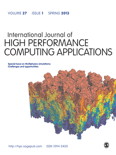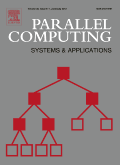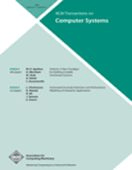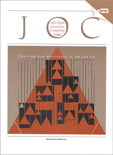
INTERNATIONAL JOURNAL OF PARALLEL PROGRAMMING
Scope & Guideline
Unleashing the Power of Parallel Processing
Introduction
Aims and Scopes
- Parallel Computing Techniques:
The journal investigates various parallel computing techniques including task parallelism, data parallelism, and hybrid models, aimed at optimizing performance across diverse architectures. - Heterogeneous Computing:
A significant focus on heterogeneous computing environments, exploring the integration of diverse computational resources such as CPUs, GPUs, and FPGAs to enhance processing efficiency. - Algorithm Design and Optimization:
Research related to the design, analysis, and optimization of algorithms tailored for parallel execution, addressing challenges such as load balancing, resource allocation, and scalability. - Performance Evaluation and Modeling:
Studies that focus on performance evaluation methodologies, benchmarking, and modeling tools that help in assessing the efficiency of parallel systems and applications. - Applications of Parallel Programming:
The journal covers a wide array of applications for parallel programming, from scientific computing and machine learning to big data processing and real-time systems.
Trending and Emerging
- Machine Learning and AI in Parallel Programming:
There is a growing trend towards integrating machine learning and AI techniques into parallel programming frameworks, enabling smarter resource management and optimization strategies. - Dynamic and Adaptive Systems:
Research is increasingly focused on dynamic and adaptive systems that can adjust their execution strategy in real-time, particularly in heterogeneous environments, enhancing application resilience and performance. - Graph Processing and Analysis:
The importance of graph processing techniques has surged, driven by the need for efficient algorithms capable of handling large-scale graph data in applications such as social networks and bioinformatics. - Edge Computing and IoT Applications:
Emerging themes include parallel programming for edge computing and Internet of Things (IoT) applications, highlighting the need for efficient processing in resource-constrained environments. - Energy Efficiency and Sustainability:
There is a notable emphasis on energy-efficient parallel computing solutions, as researchers seek to minimize the environmental impact of high-performance systems while maintaining performance.
Declining or Waning
- Legacy System Support:
Research focused on legacy systems and their integration with modern parallel programming techniques has decreased, as newer architectures gain traction and older systems become less relevant. - Basic Parallel Programming Models:
The exploration of fundamental parallel programming models, such as simple message passing or basic shared memory models, is becoming less common, as the community moves towards more complex and hybrid approaches. - Manual Optimization Techniques:
There is a noticeable decline in papers discussing manual optimization techniques for parallel programming, as automated tools and machine learning-driven optimization methods gain popularity. - Static Analysis for Parallel Programs:
Research on static analysis techniques specifically for parallel programming appears to be waning, possibly due to the increasing complexity and dynamic nature of contemporary parallel applications. - Single-threaded Performance Enhancements:
The focus on enhancing performance in single-threaded applications is diminishing, as the emphasis shifts towards leveraging multi-core and distributed computing environments.
Similar Journals

International Journal of Innovative Computing Information and Control
Empowering research in computing and control.International Journal of Innovative Computing Information and Control, published by ICIC INT, is a prominent platform dedicated to advancing the fields of computational theory, information systems, software engineering, and theoretical computer science. Since its inception in 2007, the journal has garnered attention for its rigorous peer-reviewed research and has established itself within the academic community, attaining a notable Q3 quartile ranking across its categories as of 2023. With an impressive track record of convergence from 2007 to 2024, this journal offers a wealth of insights and innovations for researchers and professionals striving to push the boundaries of technology and computing. While it operates under a subscription model, the journal's commitment to enhancing knowledge in the ever-evolving landscape of computational sciences makes it an essential resource for academics, providing timely articles that address contemporary challenges in the field.

Journal of Grid Computing
Empowering Innovation in Grid TechnologiesThe Journal of Grid Computing, published by Springer, stands as a pivotal resource in the dynamic field of computer science, particularly within the realms of Computer Networks and Communications, Hardware and Architecture, Information Systems, and Software. With an impressive Q1 ranking across these categories in 2023, the journal exemplifies excellence and rigor, catering to a diverse readership from researchers to industry professionals. Established in 2003, this esteemed journal is anchored in the Netherlands and releases cutting-edge research that reflects trends and advancements in grid computing technologies. Researchers can gain insights through its vast contributions, while institutions benefit from its prestigious standing within the SCOPUS framework, boasting high percentile ranks in multiple computer science categories. Though not open access, the journal provides unparalleled access options for institutional subscribers, solidifying its importance as a gateway to innovative discoveries in high-performance distributed computing.

INTERNATIONAL JOURNAL OF HIGH PERFORMANCE COMPUTING APPLICATIONS
Unlocking the Potential of High-Performance TechnologiesThe INTERNATIONAL JOURNAL OF HIGH PERFORMANCE COMPUTING APPLICATIONS, published by SAGE PUBLICATIONS LTD, is a leading academic journal dedicated to the advancement of high-performance computing in various domains, including hardware, software, and theoretical frameworks. With a strong commitment to disseminating innovative research since its inception in 1987, the journal plays a pivotal role in bridging the gap between theoretical advancements and practical applications in computing. Featuring an impressive impact across its categories—ranked Q2 in Hardware and Architecture, Software, and Theoretical Computer Science—this journal appeals to a diverse audience of researchers and professionals seeking to explore the latest developments and applications in high-performance computing. The journal is accessible via various open access options, ensuring that cutting-edge research is available to a wide readership, fostering collaboration and knowledge-sharing within the global computing community. Scholars interested in pushing the boundaries of technology and its applications will find this journal an invaluable resource as it continues to evolve towards its projected convergence years, extending its influence through 2024 and beyond.

PARALLEL COMPUTING
Pioneering Insights in Parallel and Distributed Technologies.PARALLEL COMPUTING is a premier academic journal dedicated to advancing research in the dynamic and rapidly evolving field of parallel and distributed computing. Published by Elsevier, this journal has been at the forefront of technological advancements since its inception in 1984, engaging a global audience and fostering a rich dialogue among researchers and practitioners alike. With an impressive impact factor that reflects its relevance in the academic community, PARALLEL COMPUTING is currently categorized in multiple fields, including Artificial Intelligence (Q3), Computer Graphics and Computer-Aided Design (Q2), and others, highlighting its multidisciplinary scope. As a vital resource, the journal features cutting-edge research articles, reviews, and methodologies that drive innovation across various domains such as hardware architecture, software engineering, and theoretical computer science. Although it does not offer open access, the journal's traditional publication model ensures rigorous peer review and high scholarly standards. Researchers, professionals, and students are encouraged to engage with the latest findings and contribute to the journal's commitment to excellence in parallel computing.

Cluster Computing-The Journal of Networks Software Tools and Applications
Catalyzing Progress in Software Tools and ApplicationsCluster Computing - The Journal of Networks Software Tools and Applications, published by Springer, is a premier academic journal catering to the vibrant fields of computer networks and software technologies. With an impressive impact factor and recognized as a Q1 journal in both Computer Networks and Communications and Software categories for 2023, it ranks within the top echelons of its field, boasting a Scopus rank of #50 out of 395 and #59 out of 407 respectively, highlighting its influence and reach. The journal, which has been in continuous publication since 2005, serves as a vital platform for groundbreaking research, offering insightful articles and tools that drive innovation in network computing. Researchers, professionals, and students are invited to contribute to and benefit from the dynamic discourse presented in this journal, which is pivotal for advancing knowledge and enhancing practical applications in a rapidly evolving technological landscape.

International Journal of Networked and Distributed Computing
Driving Insights in Computer Networks and BeyondWelcome to the International Journal of Networked and Distributed Computing, published by SpringerNature, a premier outlet for cutting-edge research in the realms of computer networks and distributed computing systems. Established as an Open Access journal since 2013 and based in the Netherlands, this publication strives to disseminate high-quality, peer-reviewed studies that address the complexities of contemporary computing challenges. With an impact factor that reflects its growing influence—positioned in the Q3 category for both Computer Networks and Communications and Computer Science Applications—this journal serves as a pivotal resource for scholars and practitioners aiming to advance knowledge and innovation in this rapidly evolving field. The journal encompasses diverse topics, from network protocols to distributed algorithms, ensuring that researchers, professionals, and students can find relevant insights and methodologies to inform their work. Join us in exploring the depths of networked and distributed computing, contributing to a collaborative academic environment that shapes the future of technology.

ACM TRANSACTIONS ON COMPUTER SYSTEMS
Pioneering Insights in Distributed Systems and BeyondACM Transactions on Computer Systems (ISSN: 0734-2071, E-ISSN: 1557-7333), published by the Association for Computing Machinery, stands as a leading journal in the field of computer science, particularly known for its focus on the design and performance of computer systems. Since its inception in 1983, the journal has fostered significant advancements in areas such as operating systems, networking, and distributed systems, making invaluable contributions to both academia and industry. Consistently ranked in the second quartile (Q2) of computer science journals, it holds a commendable position at #81 out of 232 in the Scopus rankings, reflecting its robust impact and relevance, with a percentile of 65th among general computer science publications. Although the journal does not currently offer open access options, its high-quality peer-reviewed content remains essential reading for researchers and professionals keen on deepening their understanding of computer systems and their evolution until 2024 and beyond. Engaging with this journal not only keeps one informed of the latest trends but also serves as an excellent platform for scholarly communication and collaboration.

SCIENCE OF COMPUTER PROGRAMMING
Transforming Ideas into Computational ExcellenceScience of Computer Programming, published by Elsevier, is a leading journal dedicated to advancing knowledge in the fields of computer programming, computational theory, and software development. With a focus on interdisciplinary research that spans computational methodologies, information systems, and simulation modeling, this journal plays a vital role in disseminating innovative findings and fostering collaboration among experts in these dynamic areas. With a respectable impact factor and ranked in various Scopus Categories such as computational theory (Q3) and information systems (Q2), it provides a platform for high-quality scholarly articles that push the boundaries of programming science. Although currently not open access, the journal offers invaluable insights for researchers, professionals, and students alike, ensuring they are equipped with the latest advancements and methodologies to thrive in an ever-evolving technological landscape. The journal covers research from its convergence starting in 1981 and continues to welcome groundbreaking contributions as it looks forward to an exciting future through 2025 and beyond.

INFORMS JOURNAL ON COMPUTING
Fostering Collaboration in Computing and BeyondINFORMS JOURNAL ON COMPUTING, published by INFORMS, stands as a quintessential platform for disseminating cutting-edge research and innovative methodologies in the realms of computing, information systems, and operations research. Since its inception in 1996, this journal has consistently maintained a prestigious Q1 quartile ranking across multiple categories, including Computer Science Applications, Information Systems, and Management Science and Operations Research, reflecting its significant impact and relevance in the academic community. The journal serves as a vital resource for researchers, professionals, and students alike, fostering interdisciplinary dialogue and the advancement of theoretical and practical contributions in computing. With no open access restrictions, it remains accessible to those engaged in the pursuit of knowledge and innovation in a rapidly evolving field. Housed in the United States, the journal continues to thrive, enriching the discourse in technology and its applications until 2024 and beyond.

JOURNAL OF SUPERCOMPUTING
Unraveling the Complexities of Theoretical Computer ScienceJOURNAL OF SUPERCOMPUTING is a premier academic journal published by SPRINGER, situated in the Netherlands, that has made significant contributions to the fields of computer science, particularly in hardware and architecture, information systems, software, and theoretical computer science. With a robust publication history spanning from 1987 to 2024, this journal has cultivated a strong reputation, evidenced by its Category Quartiles ranking in the Q2 category across multiple relevant domains in 2023. The journal's Scopus rankings further underscore its influence, boasting a 78th percentile in mathematics and theoretical computer science, revealing the high quality of research disseminated within its pages. As vital discourse unfolds in the realm of supercomputing—where innovative techniques and technologies rapidly evolve—this journal serves as a crucial platform for researchers, professionals, and students to explore cutting-edge studies and build upon the foundations of knowledge in this dynamic field.